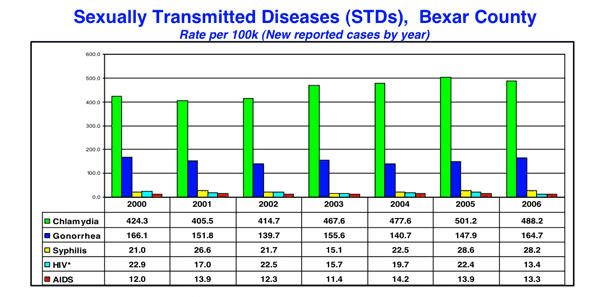Look around! Chances are that within 10 feet of you is someone carrying a sexually transmitted disease.
The National Center for Disease Control and Prevention issued a 2008 report that revealed one in every four girls ages 14-19 in the United States has a sexually transmitted disease. In 2006, the San Antonio Metropolitan Health District issued a profile stating that for every 100,000 people in Bexar County, there are 7,078 newly reported cases of STDs.
Kevin Fenton, M.D., director of CDC’s National Center for HIV/AIDS, Viral Hepatitis, STD and TB Prevention, said that this data poses significant health risks for people in the United States.
Often, sexual activity is practiced before the numerous consequences that accompany it are realized. Abstinence or a long-term monogamous relationship with someone who is not infected is the only sure way to steer clear of STDs.
Dolly Rosas, Nurse/Coordinator of Palo Alto’s Health Center, said, “Abstinence is 100 percent effective, but we have to face our reality.”
The reality is that sexual activity is at a record high among teens. Many experts propose that students get educated, use a latex condom consistently and be routinely checked by a doctor.
Palo Alto’s Health Center, located in Room 129 in the Student Center, promotes wellness and health awareness for students.
“We do address STDs at Palo Alto, but it always remains confidential,” said Rosas.
The five most common types of STDs that evolve from sexual activity are human papillomavirus (HPV), chlamydia, syphilis, gonorrhea and HIV/AIDS.
HPV is contracted through vaginal or anal sex. HPV can cause many types of cancer; however, HPV usually is symptom free.
Recently, a vaccine was created to help prevent HPV in teenage girls. This vaccine, Gardasil, prevents only four of the dozens of strands of HPV that cause cervical cancer.
“I do worry about contracting these diseases. The reason is that a majority of them have no cure and are terminal,” said Alicia Espinoza, a sophomore studying English and Journalism at Palo Alto College. “Sometimes your partner might not even tell you that he or she has an STD.”
Chlamydia is the most frequently reported sexually transmitted disease. Chlamydia can also be silent. Later on in life, it can cause infertility in women. The symptoms are widespread, ranging from nausea to pain while urinating.
Dr. Emily J. Erbelding, an infectious diseases specialist at Johns Hopkins Bayview Medical Center, said, “Sexually transmitted infections have been called a hidden epidemic because a lot of these conditions are going to be asymptomatic when they’re diagnosed. ... But they’re highly common.”
Syphilis is often called the “great imitator,” because its symptoms often mirror symptoms of other illnesses such as the flu or bladder infection. Sores are the first indicator of a syphilis outbreak. If syphilis is not detected soon enough, paralysis, dementia, numbness and damage to the internal organs may occur.
Gonorrhea is the easiest STD to contract. It is spread through the penis, vagina, mouth and/or anus, and ejaculation does not have to occur to contract it. Much like other STDs gonorrhea can be transmitted from a mother to her newborn during delivery.
For men, symptoms include a discolored discharge from the penis. In women, the symptoms can resemble those of a bladder infection. If not treated, the infection can spread to the bones and joints. Most people who are infected with gonorrhea have also contracted chlamydia.
John M. Douglas, Jr., M.D., director of CDC’s Division of STD Prevention said, “STD screening and early treatment can prevent some of the most devastating effects of untreated STDs.”
HIV/AIDS is the deadliest STD. It is easily contracted if a person has already been infected with another STD, such as herpes or syphilis. HIV is spread through vaginal, blood or semen fluids, which limits contraction to needles, sexual activity and breastfeeding of an infected mother to a newborn. Symptoms copy flu-like tendencies and can carry on for years before possibly developing into AIDS.
Espinoza said, “It is important to stop the cycle of spreading a dangerous disease.”
You may be asking why all these facts are relevant to you. If you are sexually active, even without participating in vaginal intercourse, you are at risk.
The Palo Alto Health Center also provides referral information for testing and care of STDs. Rosas explained that the referrals they give address the physical need as well as provide education for both men and women.
“When I was in high school, I didn’t learn about STDs or the proper use of contraception,” said Espinoza.
The STD epidemic is on the rise. Without proper prevention, STDs will continue to jeopardize the uniformed.
